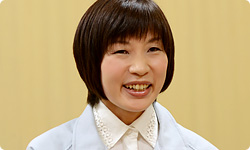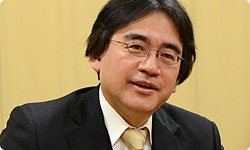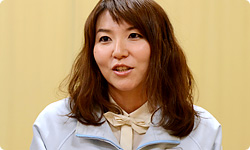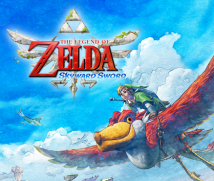3. Joining Forces
Hirono-san, you made characters this time, right?
Yes.
When you make characters, are they determined in detail from the start?
No. A lot of the time I got rough descriptions, like, “Make him sort of such-and-such.”
At first, you receive vague requests, but in the end, they turn out so rich. I’m interested in that.
At first, I just let my imagination go at it.
Oh, you do? (laughs)
When I became involved with this project, the landforms weren’t done yet, so, for example, when I thought about Zelda’s outfit, the setting was the sky, so I thought, “Red is good to set against the blue sky.”
Okay.
And there’s bird-riding, so I would imagine all sorts of things like, “Flowing cloaks would be cool,” and, since Skyloft is up high, “The climate must be cool.” I talked with the people in charge of the landforms, and the design leader said, “All right, let’s make it the kind of world where people wear these kinds of clothes,” and made the characters that way.
Did the design leader say, “Let your imagination run free!” and give you a push?
Yeah! (laughs) In thinking about the characters, I prepare a wide variety of illustrations, and sometimes others come up with ideas based on those, and we narrow them down for a few models, for which the planners and scriptwriters come up with distinctive dialogue, and the sound staff add in actual voices, so in the end ideas and material from all kinds of people get tightly packed into a single character.
In other words, you all join forces to make the characters rich.
That’s right.
Like a combined attack? (laughs)
Yes. That’s how they end up so rich. (laughs)

Speaking of rich characters, how did Ghirahim end up so rich?
At first, of course, none of that had been set.
What were you given to begin working with?
That he is an opponent for sword battles, and a Demon Lord who has some sort of objective, and his personality is a little affected and vain.
That was your assignment, and that’s how he ended up?! (laughs)
Yes. He’s an important character, but I didn’t have any more details, so we all threw out ideas and solidified his image. Design-wise, the opinion arose that if there is a shape to serve as a symbol of a character, that character will make a stronger impression, so he turned out with a design that features lots of diamond shapes. And we adopted that not just for his outfit, but for his effects, too.
And like we mentioned earlier, the people in charge of the cinematic scenes and script added as many ideas as they could. (laughs)
We all joined forces, and a note like “He moves in a weird, wriggly way,” that only existed in a written form, was worked on by those who draw the storyboards and changed into pictures of better quality.
And someone in charge of enemies said he wanted Ghirahim’s tongue to slither out in order to emphasise his creepiness. So we even had to include his tongue in his bone structure12 and so forth. 12Bone structure: This term is used when creating movable body parts in computer graphic tools for animation.
You went to all the trouble of making his tongue and putting in joints for it?

Yes. Then we could make this scene where he first appears and his tongue shoots out.
And the sound staff really got into it, saying, “We want his voice to be more like this!”
That’s right! (laughs)
As a result, we ended up having him all in tights, coming out like this (making a pose like Ghirahim when he appears), laughing loudly like, “Mwa ha ha...” (laughs)
(laughs)
So Ghirahim was nurtured to completion by everyone.
The result of everyone joining forces was that he turned into such an intense character.
How does such a vain character strike you from a woman’s perspective?
I think everyone loves him.
(nodding in unison) Yes!
Is that so? (laughs)
Ghirahim even says in the game, “I don’t mind if you call me Lord Ghirahim.”
Some people call him Lord Ghira.
Yes! (laughs)
He’s really popular. (laughs)
I think he’s really loved.
Your cooperative creative process turned him into an enemy that you girls adore. (laughs)
I believe so. He appears several times and his dialogue is distinctive, so I hope people will have a good time fighting him.
I see. I’d like to ask Hosaka-san, who was involved with planning, about something different. You worked on the volcano. What themes did you begin working with?
I was involved with the planning of the volcano’s second quest.
In other words, you thought of volcano gameplay for players who have already been through it the first time and learned the basics.
That’s right. They’ve already struggled and eventually learned how to defeat a strong opponent the first time, so I was told things like, “Have a bunch of normal enemies appear,” and “Instead, make a new enemy appear.”
That way of putting forth requests is interesting, too. When you hear things like that, how do you begin thinking about it?
First, I write up as many kinds of gameplay examples as I can think of using items that you get in the dungeon. Then, rearranging them like puzzle pieces, I thought up a flow of gameplay, like once you’ve mastered these basics, then you can use it over here.

First you prepare structural elements and think of the progression through the dungeon.
That’s right. But in thinking about the dungeon, there was something that I was particular about. There was a place where every now and then a rock would fall down and lots of scary opponents would rush to attack, and Link, as small as he is, would wade in alone.
One might wonder why he’s there all alone.
Exactly. I know I can’t do it. He does have this great goal of rescuing Zelda, but if it were me, I would get irked along the way. So then I had him get help from characters who appear in the dungeon.
The characters praise him.
They praise Link?
(happily) Yes, that’s right! (laughs)
